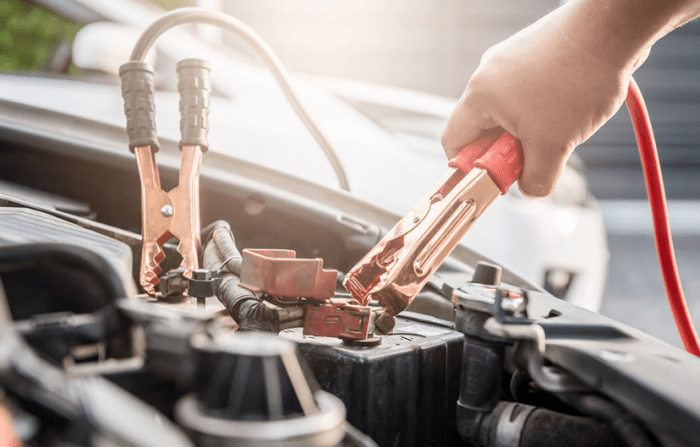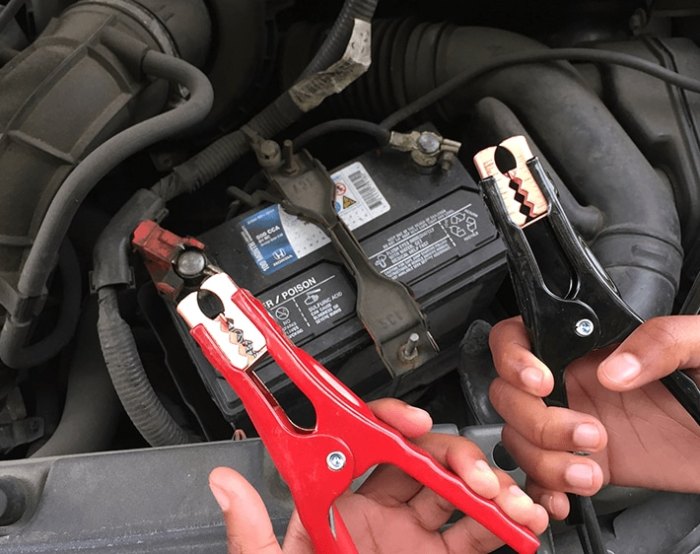How to jumpstart a car with a dead battery? It’s a scenario most drivers will face at some point, and knowing the right steps can save you a lot of hassle (and maybe even a tow truck bill!). This guide breaks down the process, from safety precautions to troubleshooting common problems, ensuring you can get back on the road quickly and confidently.
We’ll cover everything from identifying your battery terminals to using a jump starter pack, so you’ll be prepared for any dead battery emergency.
Dead batteries are annoying, but knowing how to handle them can be a real lifesaver. This isn’t rocket science, but getting the process wrong can lead to sparks, shocks, or even damage to your car’s electrical system. Follow these steps carefully, and you’ll be back in action in no time. We’ll cover everything from choosing the right jumper cables to understanding the different types of car batteries.
Safety Precautions Before Jump Starting
Jump-starting a car can be a lifesaver, but doing it wrong can lead to some serious issues. Incorrect procedures can cause sparks near flammable fluids, potentially resulting in a fire or explosion. Moreover, the high voltage involved can cause burns or even electrocution if you’re not careful. Taking the necessary safety precautions is crucial to protect yourself and your vehicle.Improper jump-starting can lead to damage to your car’s electrical system, including frying sensitive electronics like the computer module or alternator.
This damage can be expensive to repair, making safety precautions a cost-effective measure in the long run. Always prioritize safety to avoid injury and costly repairs.
Personal Protective Equipment
Wearing appropriate personal protective equipment (PPE) is paramount when jump-starting a vehicle. This minimizes the risk of injury from potential sparks, acid splashes, or accidental contact with electrical components.
- Safety glasses protect your eyes from sparks and potential battery acid splashes.
- Gloves, preferably rubber or insulated, protect your hands from acid burns and electrical shocks.
Preventing Vehicle Contact
It’s vital to ensure that the two vehicles aren’t touching each other while jump-starting. Contact between the vehicles could create a ground fault, leading to a short circuit and potential damage to the electrical systems of both cars.To prevent contact, park the vehicles at least a couple of feet apart. This separation minimizes the risk of accidental contact between metal parts of the vehicles.
Ensure the vehicles are on a level surface to further reduce the risk of any accidental contact.
Essential Safety Equipment
Having the right equipment readily available before you begin ensures a smooth and safe jump-start process. Improper tools can lead to inefficient connections and increased risk of accidents.
- Jumper cables: Choose heavy-duty cables with well-insulated clamps to ensure good conductivity and prevent shorts.
- Work gloves: Rubber or insulated gloves offer protection against acid and electrical shocks.
- Safety glasses: Protect your eyes from sparks and splashes.
- A well-maintained vehicle with a fully charged battery to provide the jumpstart:
Identifying the Car Battery and Cables

So, you’ve got a dead battery. Before you even think about hooking up those jumper cables, you need to know where everything is and what you’re working with. This section will walk you through identifying your car’s battery and the different types of jumper cables you might encounter.The car battery itself is usually located under the hood, often secured in a plastic tray.
It’s a fairly large rectangular box with two prominent terminals on top. The positive (+) terminal is typically larger and marked with a plus sign, often a raised red post or cover. The negative (-) terminal, usually smaller, is marked with a minus sign and is often unpainted or black. Sometimes there are additional smaller terminals or connectors, but these are usually for accessories and not relevant for jump-starting.
Pay close attention to the placement of these terminals; you’ll need to connect the cables correctly.
Jumper Cable Types and Features
Jumper cables come in various gauges (thickness) and lengths. Thicker cables (lower gauge number, e.g., 4 gauge) are better for high-amperage jump starts, especially for larger engines or vehicles with powerful electrical systems. Thinner cables (higher gauge number, e.g., 12 gauge) might be sufficient for smaller vehicles, but they carry a greater risk of overheating and potentially causing damage.
Longer cables provide more flexibility in positioning the vehicles during the jump-start process. Look for cables with well-insulated clamps to prevent short circuits. Clamps should be sturdy and securely grip the battery terminals. Some cables have features like built-in fuses for added safety.
Identifying a Dead Battery
A dead battery typically exhibits several symptoms. The most obvious is that your car won’t start. You might also notice a clicking sound when you turn the key, indicating the battery lacks sufficient power to crank the engine. A dim or non-functional dashboard light might also be a sign of a weak or dead battery. If you have a multimeter, you can test the battery voltage directly.
A reading below 12 volts generally indicates a dead or very weak battery. A fully charged battery will typically read between 12.6 and 13 volts.
Car Battery Types and Jump-Starting Considerations
| Battery Type | Description | Jump-Starting Considerations | Common Use Cases |
|---|---|---|---|
| Lead-Acid (Flooded) | Traditional battery with liquid electrolyte. | Standard jump-starting procedures apply. Be cautious of potential electrolyte spills. | Most common type found in older vehicles. |
| AGM (Absorbent Glass Mat) | Electrolyte is absorbed into a fiberglass mat. | Generally safer than flooded lead-acid; less prone to spills. | Often found in newer vehicles and motorcycles, known for vibration resistance. |
| Gel Cell | Electrolyte is in a gel form. | Similar to AGM in terms of safety, but less common in cars. | Often used in specialized applications or off-road vehicles. |
| Lithium-ion | Uses lithium-ion technology for higher energy density. | Specific jump-starting procedures may be needed; consult your vehicle’s manual. | Becoming more common in electric and hybrid vehicles. |
Step-by-Step Jump Starting Procedure

Jump-starting a car with a dead battery is a common roadside fix, but doing it incorrectly can be dangerous. Following these steps carefully will help you get back on the road safely and efficiently. Remember, safety is paramount; if you’re unsure about any part of this process, call a roadside assistance service.
The process involves connecting jumper cables to both batteries, starting the working car, then the dead car, and finally disconnecting everything safely. The order of connection and disconnection is crucial to avoid sparks and potential damage to electronic components.
Connecting the Jumper Cables
Connecting the jumper cables in the correct order is essential to prevent short circuits and damage to the car’s electrical systems. Incorrect connections can lead to sparks, which could ignite flammable materials near the battery. Always ensure the working car’s engine is off before beginning.
- Positive to Positive: Connect one end of the red jumper cable (marked with a “+” symbol) to the positive (+) terminal of the dead battery. This terminal is usually marked with a “+” sign or is larger than the negative terminal.
- Positive to Positive (Working Car): Connect the other end of the red jumper cable to the positive (+) terminal of the working car’s battery.
- Negative to Ground (Dead Car): Connect one end of the black jumper cable (marked with a “-” symbol) to a solid, unpainted metal surface on the dead car’s engine block or chassis. Avoid connecting it directly to the negative (-) terminal of the dead battery to minimize sparks.
- Negative to Negative (Working Car): Connect the other end of the black jumper cable to the negative (-) terminal of the working car’s battery.
Starting the Cars and Disconnecting the Cables
Once the cables are connected correctly, you can proceed to start the cars. The order of starting and stopping is important for preventing damage to sensitive electronics.
- Start the Working Car: Let the working car run for a few minutes to ensure its battery is adequately charged. This provides sufficient power for jump-starting.
- Attempt to Start the Dead Car: Try starting the car with the dead battery. If it doesn’t start immediately, let the working car run for a few more minutes before trying again.
- Disconnect Cables in Reverse Order: Once the dead car starts, allow it to run for several minutes to charge its battery. Then, disconnect the jumper cables in the reverse order of connection:
- Black cable from the working car’s negative terminal.
- Black cable from the dead car’s ground point.
- Red cable from the working car’s positive terminal.
- Red cable from the dead car’s positive terminal.
Troubleshooting Common Jump Starting Issues
Jump-starting a car can sometimes be trickier than it seems. Even with careful preparation, you might run into problems. Knowing how to troubleshoot these issues can save you time and frustration. This section covers common problems and their solutions, helping you get back on the road quickly and safely.
Cables Sparking During Connection
Sparks during the connection process usually indicate a mistake in the procedure. This is dangerous and can damage your car’s electrical system. The most common cause is accidentally connecting the positive (+) cable to the negative (-) terminal, or vice-versa. Always double-check your connections before turning anything on. Ensure the clamps are firmly attached to the correct terminals, and that they aren’t touching any metal parts of the car.
If sparks continue even after rechecking connections, immediately disconnect the cables and seek professional help. Trying to continue could cause serious damage.
So, your battery’s dead? Knowing how to jumpstart is a lifesaver, especially if you’re stuck somewhere. But hey, if you were rolling in dough, you wouldn’t be worrying about that – you’d be cruising around in one of the rides listed on this awesome site, Most exclusive limited-edition luxury cars 2025 , where even a dead battery is probably a valet’s problem.
Anyway, back to basics: remember to connect the cables correctly to avoid frying your electronics!
Car Doesn’t Start After Jump Starting
If your car still won’t start after a successful jump-start, the problem might be more significant than a dead battery. The jump start only provides enough power to temporarily start the engine; it doesn’t charge the battery. Several issues could prevent the car from starting, including a faulty alternator, a damaged starter motor, or other electrical problems. Check the battery terminals for corrosion and clean them thoroughly if necessary.
If the car starts but dies immediately, the alternator likely isn’t charging the battery. If the engine cranks but doesn’t start, the starter motor might be faulty. In these cases, professional help from a mechanic is recommended.
Jump Start Cables are Not Making Good Contact
Poor contact between the jump start cables and the battery terminals is a frequent cause of failure. This is usually due to corrosion on the terminals, loose connections, or cables that are too short or damaged. Before attempting a jump start, clean the battery terminals with a wire brush to remove any corrosion. Ensure that the clamps are securely fastened to the terminals, making good contact.
So, your battery’s dead, right? Knowing how to jumpstart is a lifesaver, especially if you’re trying to avoid a pricey tow. But imagine needing a jump for, say, a Rolls-Royce; checking out the Cost to insure a Rolls-Royce in 2025 might make you think twice about neglecting basic car maintenance. Anyway, back to jumpstarting – remember to connect the cables correctly to avoid frying your electronics!
If the cables are damaged or too short to reach comfortably, replace them or use longer cables. If the problem persists even after these checks, there might be an issue with the cable’s internal wiring.
Flowchart for Troubleshooting Jump Starting Problems
A visual representation can be very helpful for systematically addressing problems during a jump start. The flowchart below Artikels a logical sequence of troubleshooting steps.
Imagine a flowchart with the following steps:
- Start: Car battery is dead.
- Check Connections: Are the jumper cables correctly connected (positive to positive, negative to negative)?
- Yes: Proceed to step
4. No
Correct connections and return to step 4.
- Attempt Jump Start: Does the car start?
- Yes: Disconnecting cables carefully. Problem solved. No: Proceed to step 6.
- Check Cables & Terminals: Are the cables securely connected and free of corrosion? Are the battery terminals clean?
- Yes: Proceed to step
8. No
Clean terminals and re-secure connections. Return to step 4.
- Check Battery: Is the battery itself faulty (e.g., cracked, swollen)?
- Yes: Replace the battery. No: Proceed to step 10.
- Check Alternator/Starter: Could the alternator or starter be the problem?
- Yes: Seek professional help. No: Investigate other potential electrical issues and seek professional help.
- End:
Alternative Jump Starting Methods
So, your car battery’s dead, and you’re not thrilled about the prospect of finding jumper cables and another car. Luckily, there are other ways to get your engine cranking! One popular option is using a jump starter pack, a portable power source that can provide the necessary boost to your car’s battery.
Jump Starter Pack Operation
A jump starter pack is essentially a portable battery with powerful enough output to jumpstart a car. These packs typically come with clamps similar to those on jumper cables, but the connection process is often simpler and safer. Most jump starter packs have clearly labeled positive (+) and negative (-) terminals, making it easy to avoid accidental short circuits.
You connect the clamps to your car battery terminals, just like with jumper cables, but the pack itself is not connected to another vehicle. The process is usually explained in detail in the instruction manual provided with the jump starter pack. Many units have built-in safety features like reverse polarity protection to prevent damage to the electronics. Once connected, you activate the jump starter pack and wait for it to supply enough power to crank the engine.
After starting the car, disconnect the clamps, ensuring you disconnect the negative clamp first, and then recharge the jump starter pack.
Jump Starting: Jumper Cables vs. Jump Starter Pack
Both methods achieve the same goal – starting a dead car battery – but they differ significantly in convenience and safety. Jumper cables require a second vehicle with a functioning battery, while a jump starter pack is completely self-contained. Jumper cables can be more challenging to use correctly, especially for someone unfamiliar with the process, and risk short circuits if not handled carefully.
Jump starter packs often incorporate safety features, simplifying the process and reducing the risk of mistakes.
Advantages and Disadvantages of Each Method
Using jumper cables is generally cheaper upfront, as a good set of cables is significantly less expensive than a jump starter pack. However, it requires a second vehicle and a willing helper. It’s also more prone to user error, leading to potential damage to the vehicle’s electrical system if connections are made incorrectly.Jump starter packs offer unmatched convenience. They’re portable, require no second vehicle, and are generally safer due to built-in safety features.
The main disadvantage is the higher initial cost. Furthermore, jump starter packs need to be recharged after each use, and their capacity may not be sufficient for very large car batteries or in extremely cold temperatures. The longevity of a jump starter pack is also dependent on its quality and maintenance.
Post Jump Start Procedures
Okay, so your car’s sputtering back to life after that jump start – awesome! But don’t just drive off into the sunset yet. There are a few crucial steps to take to ensure this doesn’t become a recurring problem and to make sure your car’s electrical system is healthy. Taking a few extra minutes now could save you a lot of hassle later.After successfully jump-starting your car, it’s essential to check both the battery and the charging system.
A successful jump start doesn’t automatically mean everything is fine. The problem might lie with the battery itself, the alternator (which charges the battery while the engine runs), or even a parasitic drain (something constantly drawing power from the battery even when the car’s off). Ignoring these issues could lead to another dead battery – and potentially more serious problems down the road.
Battery and Charging System Checks
After driving for at least 30 minutes to allow the alternator to charge the battery, you should check the battery voltage using a multimeter. A healthy battery should read around 12.6 volts when not charging and around 13.5 to 14.5 volts while the engine is running. Anything significantly lower suggests a problem with either the battery itself or the alternator.
If the voltage is low even after driving, you’ll need to get your battery and charging system tested by a mechanic. They can determine if the battery needs replacement, the alternator needs repair, or there’s another electrical issue at play. For example, a consistently low voltage reading even after a long drive could indicate a faulty alternator that’s not adequately charging the battery.
This is a common scenario, and a mechanic can diagnose and resolve it.
Addressing Persistent Battery Issues
If your car battery continues to have problems even after jump-starting and checking the charging system, don’t delay seeking professional help. Repeated jump-starts can actually damage the battery further. A mechanic can perform a thorough diagnostic test to pinpoint the root cause. Possible issues include a faulty battery, a failing alternator, a parasitic drain (a hidden electrical draw), or even a problem with the car’s starting system.
Ignoring these issues can lead to a complete battery failure, leaving you stranded. It’s better to address the underlying problem promptly rather than repeatedly resorting to jump starts.
Preventing Future Dead Battery Situations, How to jumpstart a car with a dead battery
Preventing a dead battery is much easier than dealing with one. Regular maintenance is key. A simple habit of checking your battery regularly can prevent significant problems down the line.
Preventative Battery Maintenance
Regular maintenance can significantly extend the life of your car battery and reduce the chances of it dying unexpectedly. Here’s a list of preventative steps:
- Visual Inspection: Check the battery terminals for corrosion (white, powdery buildup). Clean them with a wire brush and baking soda solution if needed. This is a simple but crucial step that can improve the connection between the battery and the electrical system.
- Battery Terminal Connections: Ensure the battery cables are securely fastened to the terminals. Loose connections can lead to poor charging and eventually a dead battery. A visual check is the first step, and you should tighten the connections if they appear loose.
- Regular Voltage Check: Periodically check the battery voltage with a multimeter. This allows for early detection of any charging problems. A healthy battery will maintain a consistent voltage level.
- Professional Battery Testing: Have your battery tested by a mechanic every year or two. They have specialized equipment to assess the battery’s health and identify potential problems before they cause a complete failure. This proactive approach is more cost-effective in the long run than dealing with a dead battery on the road.
- Avoid Short Trips: Shorter trips don’t give the alternator enough time to fully recharge the battery. Try to take longer drives occasionally to ensure proper charging.
- Address Electrical Issues Promptly: If you notice any unusual electrical problems (dim headlights, slow cranking, etc.), get them checked immediately. These could be signs of a bigger problem that could ultimately lead to a dead battery.
Closure: How To Jumpstart A Car With A Dead Battery
So, there you have it – a complete guide to jumpstarting your car. Remember, safety first! Always prioritize your safety and the safety of others when working with car batteries and jumper cables. By following the steps Artikeld above and understanding the potential pitfalls, you can confidently handle a dead battery situation and get back on the road.
And remember, preventative maintenance is key to avoiding this whole mess in the future! Keep your battery terminals clean and consider regular battery testing.









